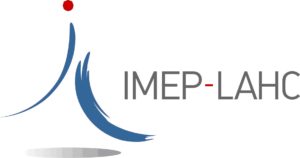Realization and optimization of SiC based nanowires Electrical Field Effect (NWFETs) biosensors for direct electrical detection of molecules
Published : 6 June 2019


![]()


Realization and optimization of SiC based nanowires Electrical Field Effect (NWFETs)
biosensors for direct electrical detection of molecules
Topic :
The development of label-free biosensors based of electrical detection of molecules is of great interest for early diagnosis of biomarkers in personalized medicine, environmental monitoring and bio-defense. In this aim, many studies are currently being carried out on sensing devices based on semiconductive silicon nanowires, for electrical detection of DNA or proteins by field effect with high sensitivity and specificity [1].
However, silicon nanowires exhibit some physicochemical instability when immerging in saline physiological solutions. It leads to some non-reliability of the measurements which, in fact, become limiting. To overcome these critical issues, other kinds of semiconducting nanomaterials or new nanowire architectures involving Si core with a passivating metal oxide shell are under investigation. In particular, silicon carbide (SiC) is a semiconductor which can advantageously replace silicon.
Indeed, SiC is already used for many biomedical applications: covering of prostheses and stents, biomimetic structures and cell reconstruction. Very recently, it has emerged as the best semiconductor candidate, chemically inert, biocompatible [2], which offers new perspectives notably for integration of in-vivo sensors. Notably, our group has recently proved the superior chemical stability of SiC NWs over Si NWs [3] in physiological conditions.
Since several years, our group is a leading group implementing SiC based Nanowires Field Effect Transistors (NWFETs) for different applications: nanoelectronics in critical environments (temperature, gas, radiation) and nanosensors of biological molecules (DNA). We have validated the concept of SiC nanowire transistors in previous PhD theses leading to a first demonstrator on an international scale.
The grafting and electrical detection of DNA using NWFETs based on 2 types of innovative SiC nanostructures have been demonstrated [4-8]. As a continuation of this work, this new PhD thesis aims to develop biosensors involving SiC based nanolines optimizing thoroughly the characteristics and performances of these devices in terms of sensitivity, detection limit, selectivity long-term functionality and real-time acquisition.
Objective:
The thesis work will focus on the development of SiC based nanolines, their integration in NWFETs, their electrical characterization, their functionalization and integration in microfluidic cells in order to be able to emphasize the electrical detection of DNA or proteins in liquid medium. The work will be principally done within 2 Grenoble laboratory partners in this project: IMEP-LaHC and LMGP.
This partnership is supplemented by surrounding technical platforms (CIME Biotech, clean rooms PTA and CIME).
Candidate profile:
The candidate should be Master of Sciences graduated in the field of Micro-Nanotechnology.
An experience in biosensing and cleanroom processing and device characterization would be a plus.
CV, marks of master (year 1 and 2) and letter should be sent before July , 15 to supervisor and co -supervisor .
Contact:
Edwige BANO, IMEP-LaHC : Supervisor
Valérie STAMBOULI, LMGP : Co -supervisor
Funding:
fellowships from EEATS doctoral school
Starting date:
1st October 2019
References:
[1] N. Gao, et al, Nano Letters. 15, p2143−2148 (2015)
[2] S.E.Saddow, Silicon Carbide Biotechnology: A Biocompatible Semiconductor for Advanced Biomedical Devices and Applications. Elsevier Sciences (2011)
[3] R. Bange, et al, Material Research Express 6, 015013 (2019)
[4] L. Fradetal, thesis of Grenoble University (2014)
[5] L. Fradetal, et al, Journal of Nanoscience and Nanotechnology 14, 5, p3391–3397 (2014)
[6] J.H.Choi et al, Journal of Physics D: Appl. Phys. 45 p235204 (2012)
[7] M. Ollivier et al, J. Crystal Growth 363 p158-163 (2013)
[8] L. Fradetal et al, Nanotechnology 27 (23) p235501 (2016)



 Contact us
Contact us How to find us
How to find us









